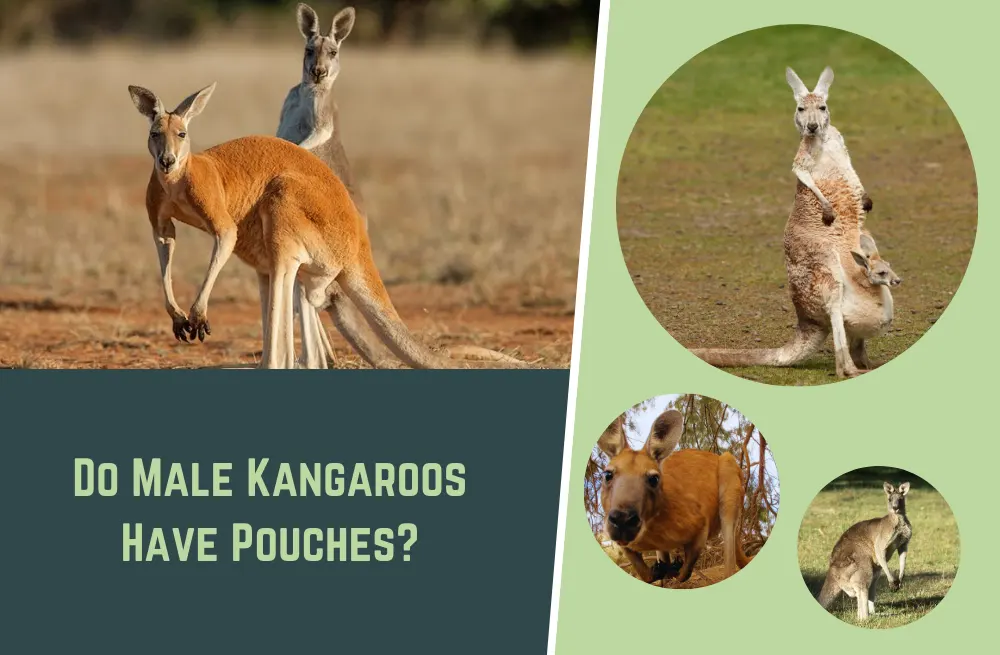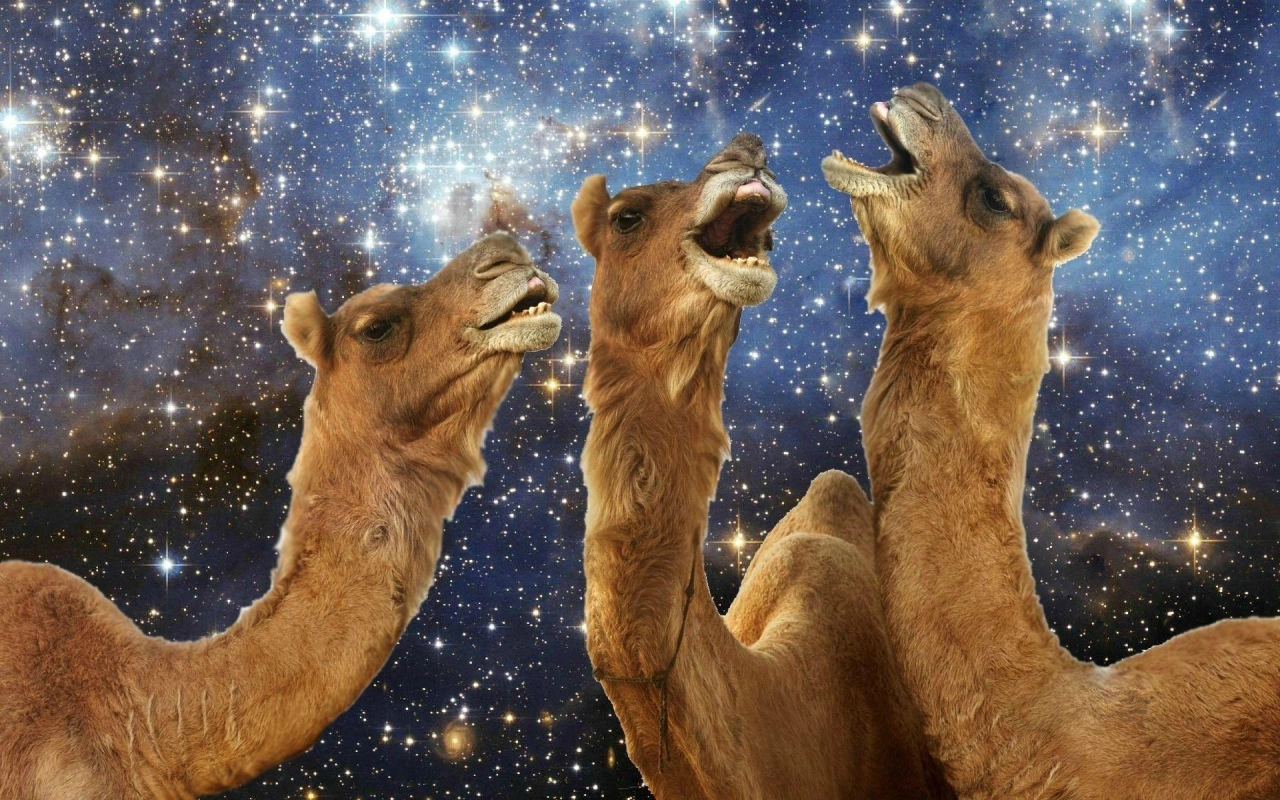The Eastern Grey Kangaroo, scientifically known as Macropus giganteus, holds a special place in the diverse wildlife of Australia. This iconic marsupial species has long fascinated people with its distinctive appearance and captivating behaviors.
From its powerful leaps to its nurturing maternal care, the Eastern Grey Kangaroo embodies the remarkable adaptations and natural wonders found in the vast landscapes of Australia.
In this article, we will delve into the fascinating world of the Eastern Grey Kangaroo, exploring its unique characteristics, habitat, behaviors, and the important role it plays in the Australian ecosystem.
So, let’s get into it!
Information
| Characteristic | Eastern Grey Kangaroo |
|---|---|
| Scientific Name: | Macropus giganteus |
| Family: | Macropodidae |
| Type: | Mammal |
| Order | Diprotodontia |
| Temperament: | Generally docile, can be aggressive if threatened |
| Lifespan: | Up to 20 years in the wild |
| Size: | Length: Varies, males larger than females |
| Weight: | Males: 50-66 kg, Females: 17-40 kg |
| Diet: | Herbivorous, primarily grasses, herbs, shrubs, and leaves |
| Distribution: | Eastern and southeastern regions of Australia |
| Habitat: | Various habitats including woodlands, grasslands, forests, coastal areas, and urban fringes |
| Conservation Status: | Least Concern (IUCN) |
| Fun Fact | Eastern Grey Kangaroos are known for their powerful hind legs and can reach speeds of up to 64 km/h (40 mph). |
Size and Physical Features
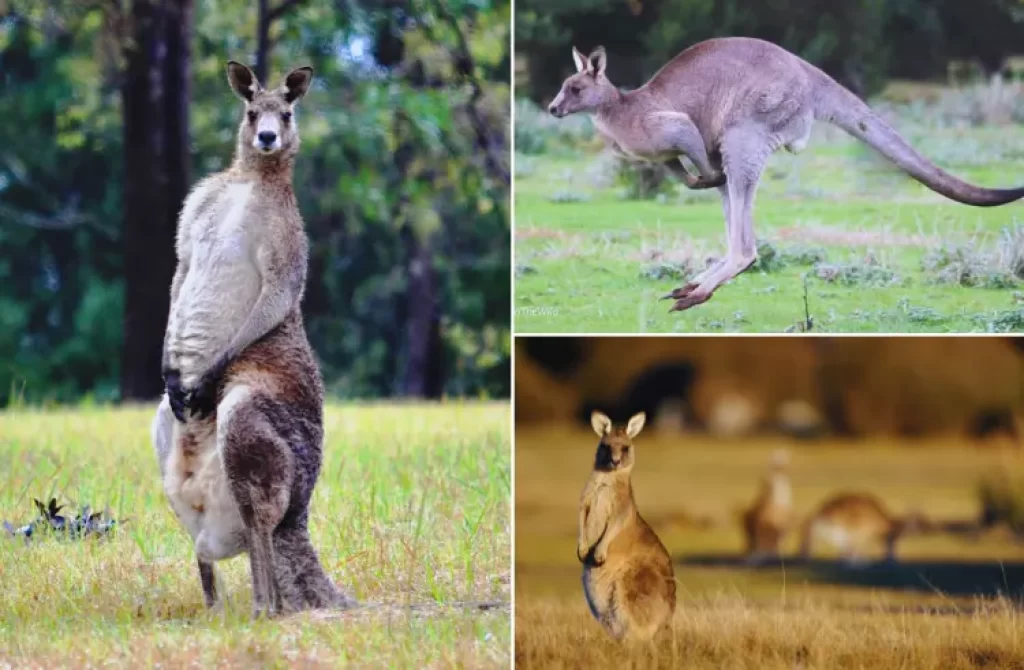
Eastern Grey Kangaroos are quite impressive when it comes to their size and physical features. Just imagine adult males weighing between 50 to 66 kg (110 to 146 lb), while females are relatively lighter at around 17 to 40 kg (37 to 88 lb). That’s quite a significant weight!
But what really stands out is their powerful tail, which can stretch over 1 meter (3 feet 3 inches) in length for adult males. It’s like having a built-in balancing tool!
Now, here’s where things get really interesting. Sometimes, these kangaroos can go beyond the normal size range. Can you believe that a kangaroo shot in eastern Tasmania weighed a whopping 82 kg (181 lb) and measured 2.64 meters (8 feet 8 inches) from nose to tail?
That’s longer than most people! And get this, there was another record-breaking individual examined by Lydekker that weighed a staggering 91 kg (201 lb) and measured an astonishing 2.92 meters (9 feet 7 inches) along the curves. That’s like having a giant, muscular kangaroo!
These incredible measurements truly highlight the remarkable size and physicality of Eastern Grey Kangaroos. It’s no wonder they capture our attention and fascination with their sheer presence.
Distinctive Appearance
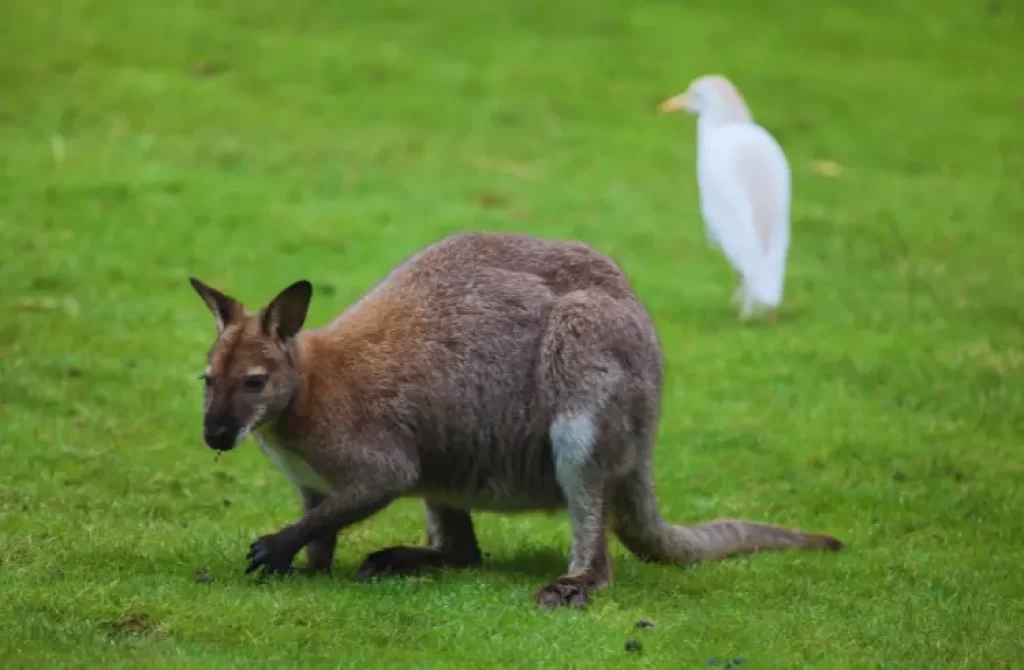
The Eastern Grey Kangaroo has several unique physical features that make it easily recognizable and distinguishable from other kangaroo species. Let’s delve into these characteristics in more detail.
Soft Grey Coat
One of the most striking features of the Eastern Grey Kangaroo is its soft grey coat. Unlike the Red Kangaroo, which can sometimes have a grey-blue hue, the Eastern Grey Kangaroo maintains a distinct and consistent grey coloration throughout its fur. This gives it a visually appealing and distinctive appearance.
Absence of Markings
While Red Kangaroos exhibit black and white markings beside their muzzles and along the sides of their face, the Eastern Grey Kangaroo lacks these distinctive patterns. Instead, their face appears smooth and uniform in color, allowing their soft grey coat to take center stage. This absence of markings adds to their elegant and understated look.
Large and Wide-Open Eyes
The eyes of the Eastern Grey Kangaroo are another notable feature. Their eyes appear comparatively larger and seem wide open, giving them a sense of alertness and curiosity.
This characteristic adds to their expressive and engaging appearance, capturing the attention of observers.
By combining these distinctive traits – the soft grey coat, absence of markings, and large, wide-open eyes – the Eastern Grey Kangaroo creates a unique and captivating visual presence.
Reproduction of Eastern Grey Kangaroos: Adaptations and Parental Care
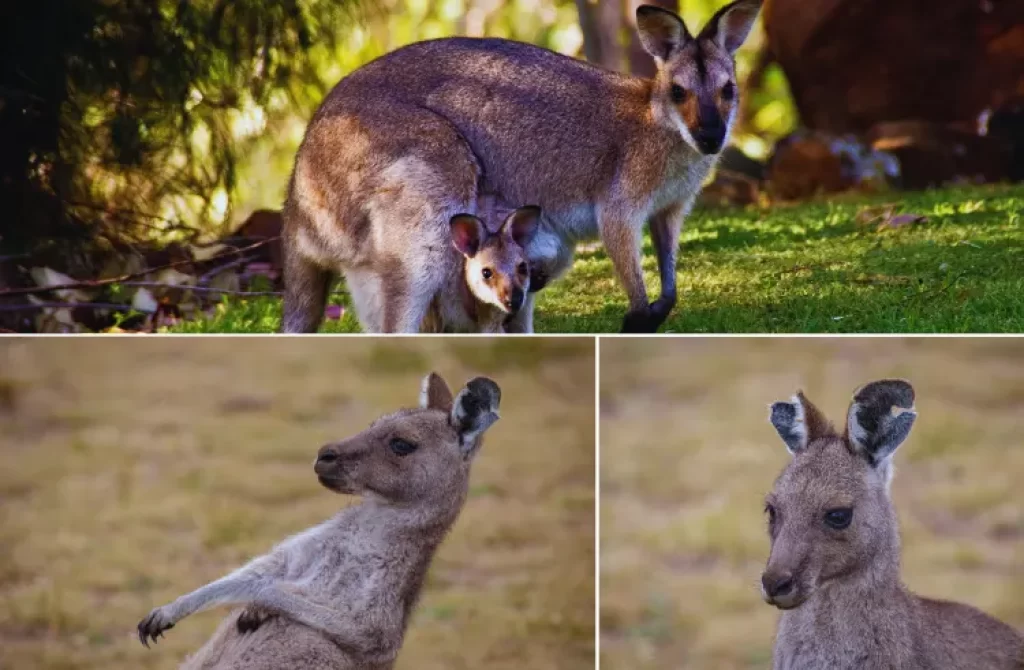
The reproductive behavior of Eastern Grey Kangaroos is fascinating and unique. Let’s explore their reproductive process and the remarkable adaptations they have developed.
Kinship Bonds
In the world of Eastern Grey Kangaroos, family ties are highly valued and can significantly impact reproductive success. Female kangaroos form strong and enduring bonds with their female relatives, creating a network of support within their social groups.
These kinship bonds play a vital role in their reproductive journey, as females who have living female relatives experience increased opportunities for successful reproduction.
By maintaining close relationships with their kin, female Eastern Grey Kangaroos benefit from shared resources, knowledge, and protection. These bonds create a cooperative environment where females can support each other throughout the reproductive process, ensuring the survival and well-being of their offspring.
Whether it’s sharing valuable parenting insights or collaborating to secure optimal habitats and resources, these kinship bonds contribute to the reproductive success of female Eastern Grey Kangaroos.
Breeding Season: Thriving Reproduction in the Summer
The Eastern Grey Kangaroo, like many other kangaroo species, exhibits a preference for the summer season when it comes to breeding. This time of year provides favorable environmental conditions and an abundance of food resources, creating an ideal setting for successful reproduction.
During this period, the Eastern Grey Kangaroos seize the opportunity to bring new life into the world, ensuring the continuity of their species.
Embryonic Diapause
The female Eastern Grey Kangaroo has an incredible ability called embryonic diapause. This means that she can temporarily halt the development of an embryo until the previous joey is ready to leave the pouch.
This adaptation allows the female to adjust the timing of birth according to environmental factors such as drought or limited food resources. It ensures that the newborn joey has the best chances of survival.
Milk Composition
The mother kangaroo produces milk that is specifically tailored to the needs of her joey. Interestingly, she can simultaneously produce two different types of milk—one for the newborn joey in the pouch and another for the older joey still dependent on her milk.
This ensures that both offspring receive the appropriate nutrients for their stage of development.
Reproductive Adaptations
During dry periods, males cease sperm production, and females only conceive if there has been sufficient rainfall to stimulate the growth of abundant green vegetation.
This adaptation ensures that the resources necessary for successful reproduction and the survival of the offspring are available.
Maternal Care
Female Eastern Grey Kangaroos take sole responsibility for caring for their young. The joeys rely heavily on their mothers for approximately 550 days, during which time they receive nourishment and protection in the pouch. After this period, they are gradually weaned and become more independent.
Sexual Maturity
Females typically reach sexual maturity between 17 and 28 months of age, while males mature at around 25 months. Once mature, they can engage in the reproductive cycle and contribute to the continuation of their species.
The reproductive strategies and adaptations of Eastern Grey Kangaroos demonstrate their remarkable ability to adapt to the unique challenges of their environment, ensuring the survival and success of their offspring.
You might also find interesting: What do Kangaroos Look like When They are Born?
Habitat and Distribution: Thriving in Diverse Environments
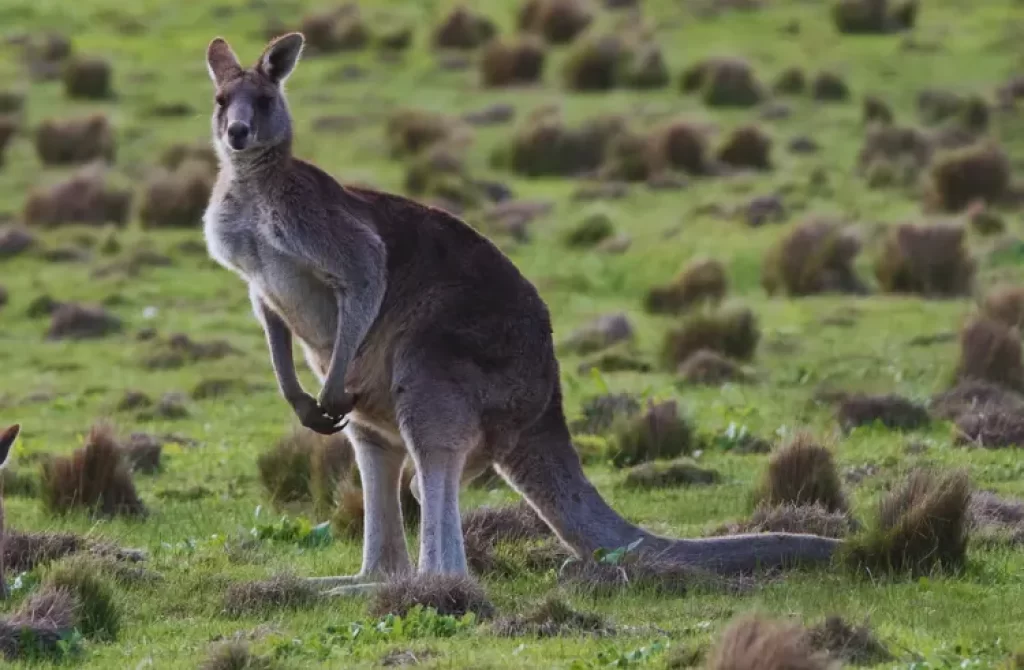
Eastern Grey Kangaroos (Macropus giganteus) are highly adaptable creatures that can be found in a variety of habitats across Australia.
Habitat Preferences
Eastern Grey Kangaroos have a preference for moister environments that offer abundant food sources and suitable shelter. Here are some key habitats they inhabit:
a) Open Woodlands: These kangaroos can be spotted grazing in open woodlands characterized by scattered trees and grassy undergrowth. Such habitats provide a mix of grazing opportunities and cover.
b) Grasslands and Savannas: Eastern Grey Kangaroos are also commonly found in grassy areas, including grasslands and savannas. These open spaces offer ample grazing opportunities and visibility.
c) Forested Areas: They can also venture into forested regions, particularly those with a more open understory. Forest habitats provide both food resources and shelter.
d) Coastal Areas: Eastern Grey Kangaroos are known to frequent coastal areas where coastal grasses and shrubs provide a source of sustenance.
e) Urban Fringes: Interestingly, these adaptable kangaroos have successfully adapted to human-altered landscapes and can be found on the outskirts of urban areas.
Geographic Distribution
The distribution of Eastern Grey Kangaroos spans across the eastern and southeastern regions of Australia. Their range extends from Queensland in the north to Victoria in the south. They are most commonly encountered in the following states and territories:
a) Queensland: Eastern Grey Kangaroos are found in various regions of Queensland, including coastal areas and inland habitats.
b) New South Wales: This species is widely distributed throughout New South Wales, inhabiting a range of habitats across the state.
c) Victoria: Eastern Grey Kangaroos are present in Victoria, with populations found in both rural and semi-urban environments.
d) South Australia: While less common in South Australia, Eastern Grey Kangaroos can still be observed in select areas within the state.
e) Australian Capital Territory: These kangaroos also have a presence in the Australian Capital Territory, particularly in nature reserves and open spaces.
The adaptability of Eastern Grey Kangaroos to different habitats and their expansive geographic distribution highlight their remarkable ability to thrive in diverse environments.
Whether in open woodlands, grassy savannas, coastal areas, or even on the fringes of urban areas, these kangaroos continue to captivate with their ability to coexist alongside humans and adapt to varying ecological conditions.
Their widespread distribution is a testament to their resilience and their status as one of Australia’s iconic and beloved marsupials.
Do Eastern Grey Kangaroos migrate?
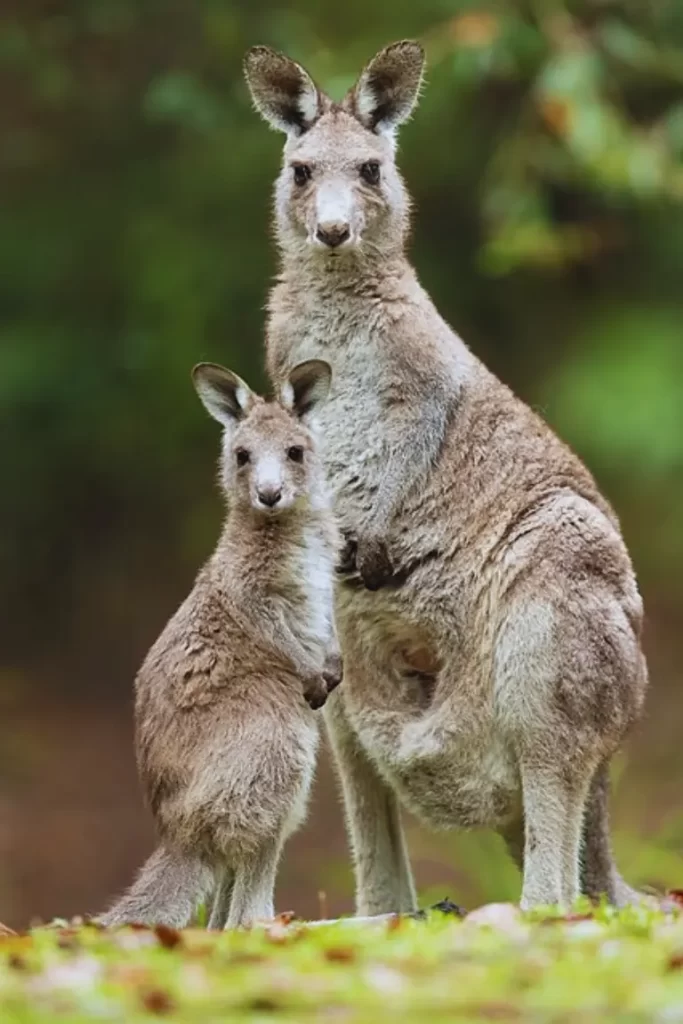
Eastern Grey Kangaroos do not engage in long-distance migration like some other species of animals. However, they do exhibit certain patterns of movement and have specific home ranges within their habitats.
Home Ranges
Eastern Grey Kangaroos establish home ranges, which are areas they inhabit and consider their territory. These home ranges typically include preferred feeding areas, water sources, and suitable shelter.
The size of the home range can vary depending on factors such as food availability, habitat quality, and population density. Home ranges for males are usually larger than those of females.
Seasonal Movements
While not considered migration in the traditional sense, Eastern Grey Kangaroos may exhibit seasonal movements within their home ranges.
They may move to different areas in search of food and water sources, especially during periods of drought or when certain resources become scarce.
These movements help them find suitable habitats and ensure their survival during changing environmental conditions.
Dispersal
Young Eastern Grey Kangaroos, particularly males, undergo a period of dispersal where they leave their natal group to establish their own territories.
This dispersal helps prevent inbreeding and promotes genetic diversity within the population. These young kangaroos may travel considerable distances in search of suitable areas to settle and establish their own home ranges.
What is the lifespan of an Eastern Grey Kangaroo in the wild?
The lifespan of an Eastern Grey Kangaroo in the wild can vary, but on average, they live around 8 to 12 years. However, some individuals have been known to live up to 20 years or more, depending on various factors such as the availability of food, water, predation risks, and overall health.
The survival rate of kangaroos can be influenced by environmental conditions, competition for resources, and potential threats from predators. Factors like disease, accidents, and human activities can also impact their lifespan.
Behavior and Social Structure of Eastern Grey Kangaroos
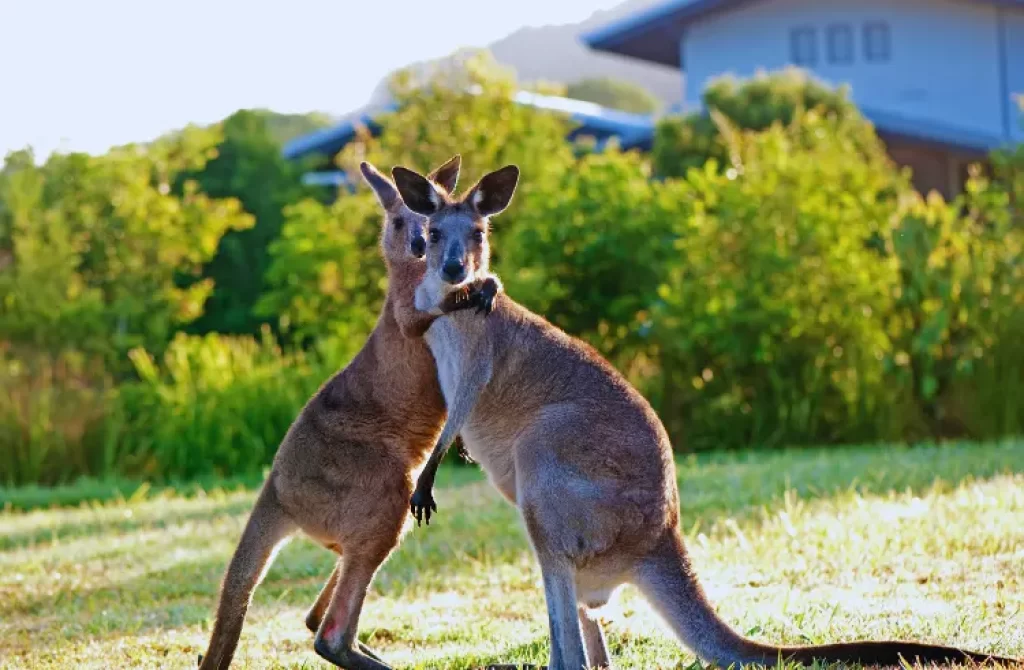
Herbivorous Diet and Digestive Adaptations
Eastern Grey Kangaroos have a predominantly herbivorous diet, relying on a diverse range of vegetation for sustenance. Their menu includes grasses, herbs, shrubs, and leaves.
To efficiently extract nutrients from fibrous plant material, they possess a unique digestive system. This enables them to thrive on a diet that might be challenging for other animals.
Powerful Hind Legs and Impressive
Speed One of the remarkable characteristics of Eastern Grey Kangaroos is their powerful hind legs. These limbs are well-developed and allow them to engage in their distinctive hopping locomotion.
With the help of their hind legs, they can cover long distances and achieve impressive speeds. In fact, a large female Eastern Grey Kangaroo holds the record for the highest recorded speed of any kangaroo, reaching a remarkable 64 km/h (40 mph).
Social Behavior and Mob Structure
Eastern Grey Kangaroos are social animals that exhibit interesting group dynamics. They form loose social groups called mobs, which consist of several individuals. A typical mob includes females, their young, and a dominant male.
Within the mob, communication plays a vital role in maintaining social cohesion and establishing dominance. Eastern Grey Kangaroos use a variety of vocalizations, including grunts and coughs, to communicate with each other.
Adaptation and Flexibility in Social Structure
The social structure of Eastern Grey Kangaroos exhibits adaptability and flexibility. Mobs can vary in size and composition, and individuals may switch groups depending on social dynamics and resource availability.
This flexibility allows them to navigate different environments and adapt to changing conditions, ensuring their survival and success as a species.
How do Eastern Grey Kangaroos communicate with each other?
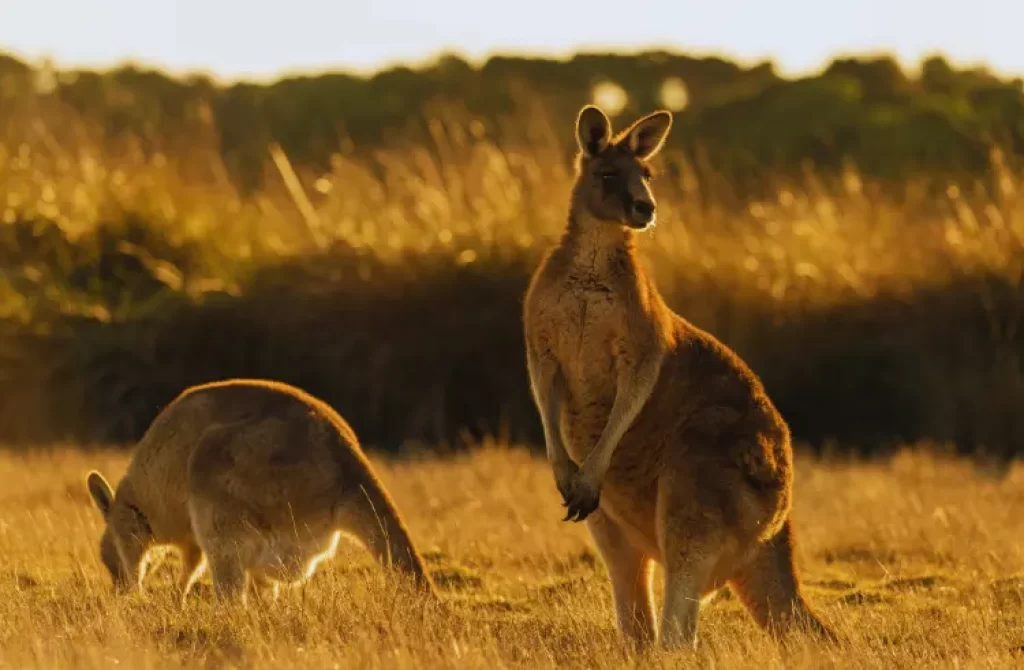
Eastern Grey Kangaroos have a diverse range of communication methods that they employ to interact and convey messages within their social groups. These communication methods include vocalizations, body language, and physical interactions.
Vocalizations
Eastern Grey Kangaroos use a variety of vocalizations to communicate with each other. These vocalizations serve different purposes and convey various emotions and intentions. Grunts are often used by males to display dominance or aggression.
Deep grunts are a way to establish authority or challenge other males in the group. Coughs and hisses may be emitted to signal warning or express annoyance or aggression. These vocalizations help maintain social order and resolve conflicts within the group.
Body Language
Body language plays a significant role in Eastern Grey Kangaroo communication. Through their posture and movements, they convey dominance, submissiveness, or different emotional states. When asserting dominance, kangaroos stand tall, puff out their chests, and make themselves appear larger.
This display signals their position in the social hierarchy. Conversely, when expressing submissiveness or fear, they crouch down, make themselves appear smaller, or retreat. T
ail movements are also an important aspect of their body language. A relaxed tail held low indicates a calm or non-threatening state, while an elevated tail can indicate alertness or aggression.
Physical Interactions
Physical interactions are another important means of communication among Eastern Grey Kangaroos. Males often engage in boxing and kicking matches, especially during periods of competition for dominance or conflicts over resources.
These matches involve using their powerful hind legs to deliver kicks to each other. While seemingly aggressive, these interactions help establish dominance and resolve conflicts without causing serious harm.
Nose-to-nose touching is a common behavior observed among kangaroos, serving as a friendly greeting and reinforcing social bonds within the group. Mutual grooming and hugging are also observed, promoting social bonding and strengthening relationships among kangaroos.
These physical interactions play a vital role in establishing trust, maintaining group cohesion, and fostering social harmony.
Do eastern grey kangaroos have predators?
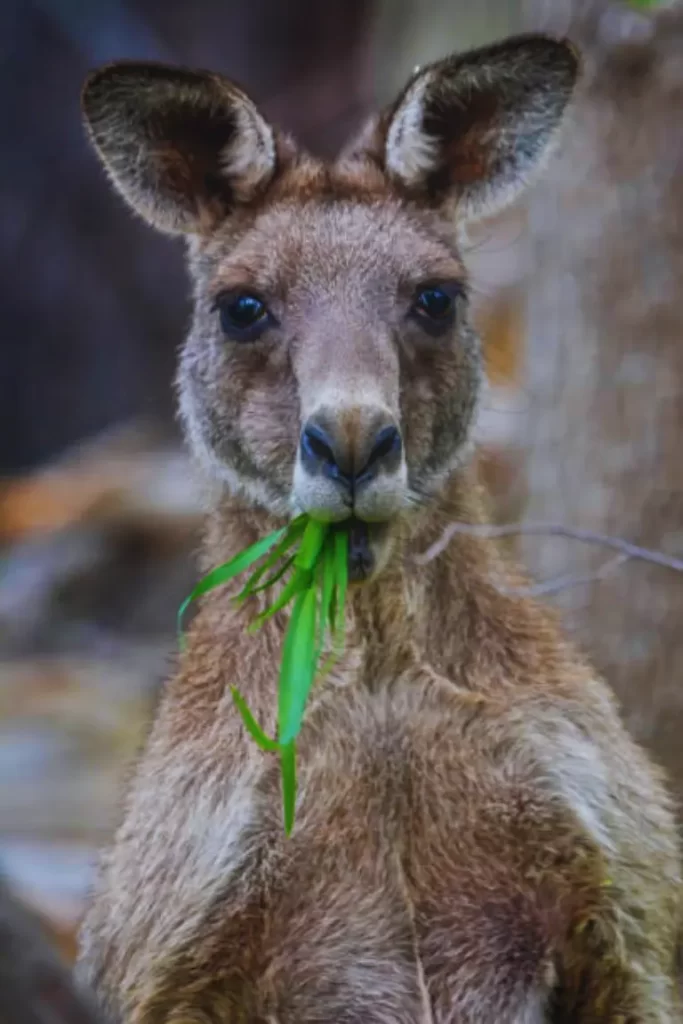
Eastern Grey Kangaroos, like many other animals, have natural predators in the wild. While they are generally large and powerful creatures, they are not exempt from predation.
Understanding the predators that pose a threat to Eastern Grey Kangaroos helps us appreciate the challenges they face in their natural environment. Here are some predators that can prey on Eastern Grey Kangaroos:
Dingoes
Dingoes, which are wild dogs native to Australia, are known to be one of the main predators of Eastern Grey Kangaroos.
They have coexisted with kangaroos for thousands of years and have developed hunting strategies to target kangaroos. Dingoes primarily target young, weak, or injured kangaroos, as well as vulnerable joeys.
Large Birds of Prey
Eastern Grey Kangaroos, especially the young and smaller individuals, can fall victim to large predatory birds such as wedge-tailed eagles and white-bellied sea eagles.
These birds have impressive aerial hunting skills and can swoop down to capture young joeys or vulnerable kangaroos.
Feral Dogs
Feral or stray dogs that have reverted to a wild state can pose a significant threat to Eastern Grey Kangaroos. These dogs, whether feral or once domesticated, can form packs and collaborate to hunt kangaroos.
Humans
While humans are not natural predators of Eastern Grey Kangaroos, there are instances where kangaroos are hunted legally for commercial purposes, such as meat and leather production. Additionally, in certain areas, kangaroo populations may be culled to manage their numbers due to concerns about overgrazing and habitat damage.
However, it’s important to note that these actions are carefully regulated and monitored to ensure the sustainability of kangaroo populations.
Eastern Grey Kangaroos have evolved several adaptations to help them evade and escape predators. Their strong and muscular hind legs allow them to hop quickly and efficiently, reaching speeds of up to 60 km/h (37 mph).
This agility and speed help them outrun potential threats. In addition, Eastern Grey Kangaroos are social animals and often form groups, known as mobs, for increased protection. By staying together, they can detect predators more effectively and have a better chance of defending themselves or fleeing to safety.
While Eastern Grey Kangaroos face predation pressures, their population remains stable and they continue to thrive in various habitats across their range.
🦘 You might also find interesting: As we explore the impact of human activities on Eastern Grey Kangaroo populations, let’s take a look at a hypothetical scenario of a battle between humans and kangaroos. Who Wins the Ultimate Fight? 😄
Status of Eastern Grey Kangaroos
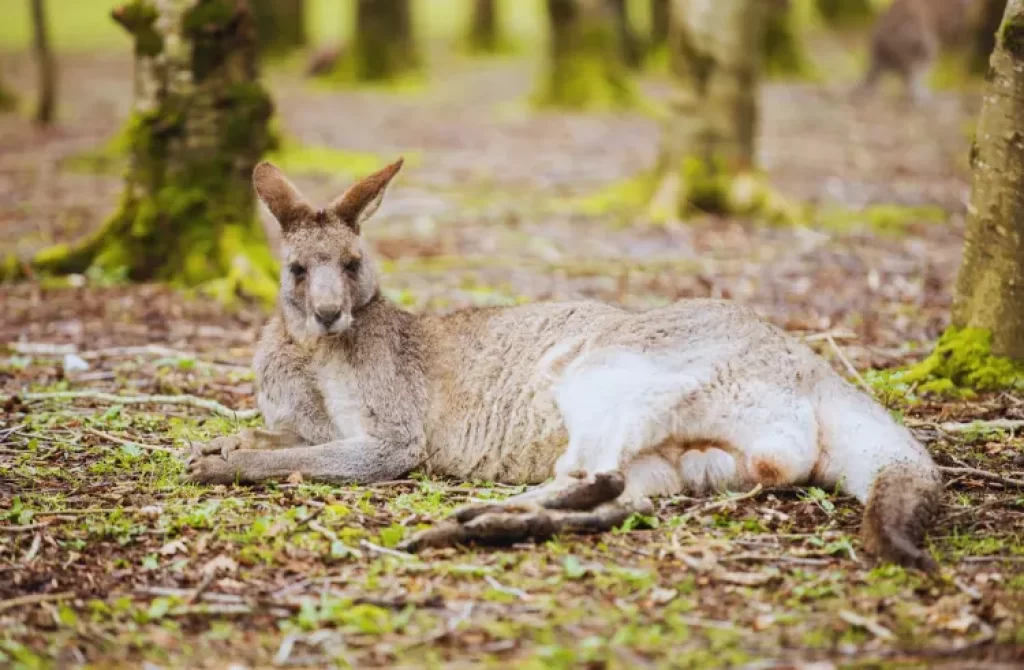
Population Dynamics and Potential Increase
While it is widely believed, there is limited concrete evidence to support the notion that kangaroo populations, including the Eastern Grey Kangaroo, have experienced significant growth since the European colonization of Australia.
This is attributed to factors such as the expansion of grassland areas, reduction in dingo numbers, and the availability of artificial watering holes.
These factors have provided favorable conditions for population growth. In 2010, the estimated population of Eastern Grey Kangaroos across Australia was approximately 11.4 million individuals.
Challenges of Overpopulation and Culling
In certain areas, the Eastern Grey Kangaroo has become so numerous that it has led to overgrazing, causing concerns for ecosystem balance and habitat integrity.
As a result, some localized populations have been subject to culling efforts, such as the Eden Park Kangaroo Cull. These measures aim to manage the kangaroo population and minimize the negative impacts on the environment.
Persistence and Adaptability
Despite commercial harvest and localized culls, the Eastern Grey Kangaroo remains common and widespread throughout its range. It has successfully adapted to various habitats, including suburban and rural areas.
In these human-modified landscapes, Eastern Grey Kangaroos have been observed forming larger groups than in natural areas. This adaptability contributes to their persistence and ability to coexist with human activities.
Conflicts with Agriculture and Land
Use The expansion of agriculture and the cultivation of crops and exotic pasture grasses have brought Eastern Grey Kangaroos into conflict with human interests. These kangaroos readily consume the fertile districts now dedicated to agriculture.
As a result, conflicts arise between the kangaroos’ feeding habits and agricultural practices. However, there have been discussions about utilizing kangaroo meat as an alternative to beef, as kangaroos’ soft feet are less damaging to erosion-prone areas.
Conservation and Future Considerations
The Eastern Grey Kangaroo still occupies its entire historical range since the arrival of Europeans in Australia in 1788.
To ensure their long-term survival, conservation efforts are necessary to maintain viable populations and manage their interactions with human activities.
Conservation strategies should focus on balancing population control measures with the preservation of their ecological roles and genetic diversity. Continued research and monitoring will provide valuable insights for sustainable management practices.
Conclusion
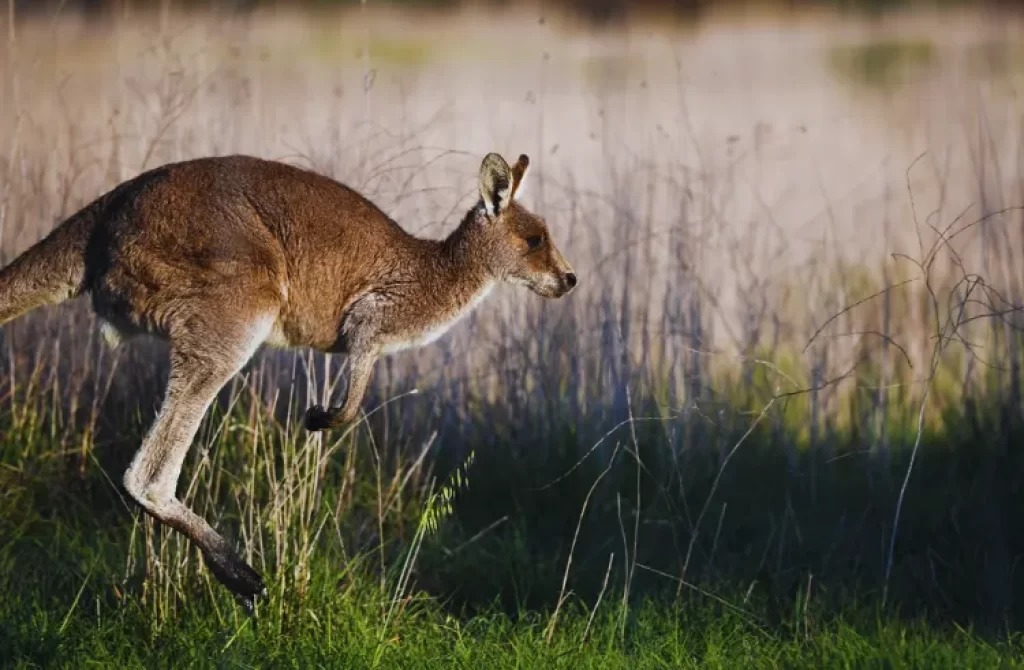
The Eastern Grey Kangaroo holds a special place in Australia’s diverse ecosystem, captivating us with its unique features and fascinating behaviors. It reminds us of the beauty and wonder of the natural world that surrounds us. As caretakers of our environment, it is our duty to understand and protect this iconic species.
By appreciating the kangaroo’s adaptability, reproductive strategies, and social dynamics, we actively contribute to the conservation of the Eastern Grey Kangaroo and the broader preservation of Australia’s precious wildlife. Together, we can ensure that future generations have the opportunity to marvel at these magnificent creatures.
If you’re eager to learn more about kangaroos and wildlife in general, we invite you to explore the other articles in our collection. You can also use the search bar to dive deeper into the wonders of the natural world. Let’s embark on this exciting journey of discovery together!
Thank you for joining us on this adventure, and we hope to continue sharing the wonders of nature with you. See you soon!
Related animals
Frequently Asked Questions (FAQ)
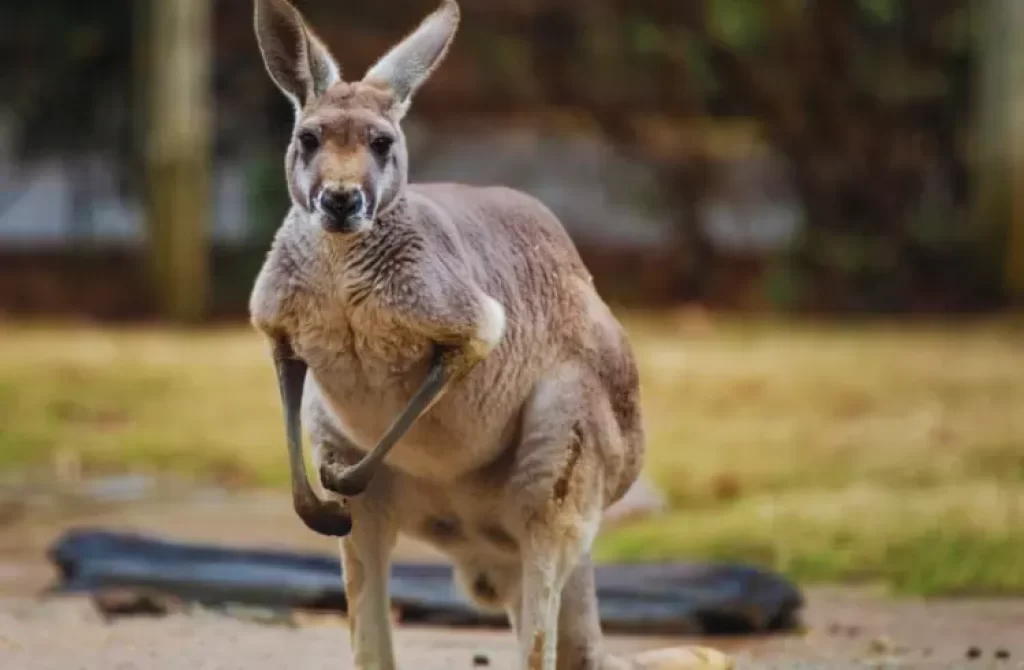
What is eastern grey kangaroo height?
The Eastern Grey Kangaroo (Macropus giganteus) is also known for its impressive size, including its height. On average, adult male Eastern Grey Kangaroos can stand approximately 1.8 to 2.1 meters (6 to 7 feet) tall when fully erect.
Female Eastern Grey Kangaroos are slightly smaller, typically reaching heights of around 1.3 to 1.5 meters (4 to 5 feet). However, these measurements can vary among individuals, and larger specimens have been recorded. The towering stature of the Eastern Grey Kangaroo is one of its distinguishing features, allowing it to survey its surroundings and navigate its environment with grace and agility.
What is the difference between a red kangaroo and an Eastern Grey Kangaroo?
The Red Kangaroo (Macropus rufus) and the Eastern Grey Kangaroo (Macropus giganteus) are two distinct kangaroo species found in Australia.
The Red Kangaroo is larger, with reddish-brown fur and a preference for arid regions. In contrast, the Eastern Grey Kangaroo has a soft grey coat, smaller size, and inhabits moister environments.
Both species have unique behaviors, with Red Kangaroos known for their speed and competitive mating behavior, while Eastern Grey Kangaroos form social groups called mobs.
What is the most aggressive kangaroo?
The male Red Kangaroo (Macropus rufus) is known to be the most aggressive among kangaroo species. During mating season, males engage in fierce battles to establish dominance and access to females.
They use their powerful hind legs and strong arms to engage in boxing matches, which can escalate into intense fights with biting, kicking, and grappling. The aggression displayed by male Red Kangaroos is a result of competition for mates and establishing their hierarchical position within the group.
Can red kangaroos breed with Eastern Grey Kangaroos?
No, Red Kangaroos (Macropus rufus) and Eastern Grey Kangaroos (Macropus giganteus) cannot interbreed and produce offspring. They are two separate species of kangaroos with distinct genetic and reproductive characteristics.
While both species belong to the Macropodidae family, they have evolved separately and do not naturally interbreed in the wild. Interbreeding typically occurs within the same species or closely related species that share a common gene pool.
How do eastern grey kangaroos protect themselves?
Eastern Grey Kangaroos protect themselves through their powerful hind legs, which allow them to hop away at high speeds. They also rely on their keen senses, social behavior in groups, defensive boxing and kicking, and seeking cover in dense vegetation.


